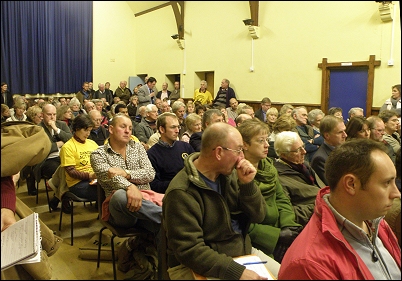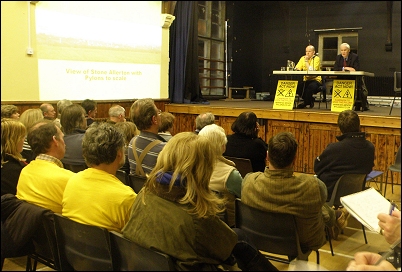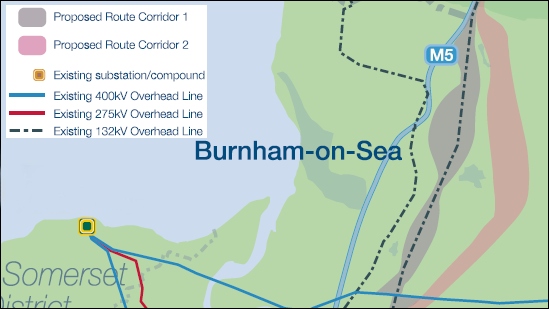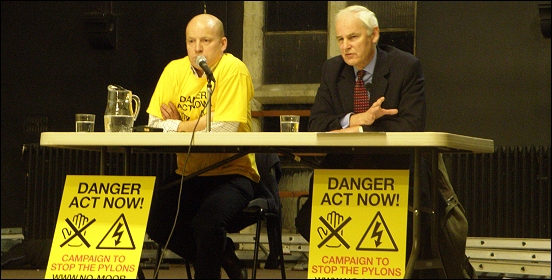Burnham-On-Sea’s MP told a public meeting of over 170 residents on Sunday night (December 6th) that he is “optimistic” of halting controversial plans for a new network of electricity pylons running through our area from Hinkley Point to Avonmouth.
As first reported by Burnham-On-Sea.com in September, the National Grid wants to connect a proposed new nuclear power station at Hinkley Point to a new sub-station near Bristol – a distance of 37 miles.
 Two potential ‘route corridors’ for the 400,000 volt, 46.5m tall pylons have been identified, with one running close to East Huntspill, Watchfield, Mark and Bason Bridge [see the routes at the bottom of this page].
Two potential ‘route corridors’ for the 400,000 volt, 46.5m tall pylons have been identified, with one running close to East Huntspill, Watchfield, Mark and Bason Bridge [see the routes at the bottom of this page].
Almost 200 concerned people flocked to Wedmore Village Hall for Sunday night’s public meeting, as pictured here.
David Heathcoat-Amory, who sat on a stage next to Andrew Scott, leader of the ‘No Moor Pylons’ campaign, urged National Grid to look at other options for the power scheme, particularly installing the power lines underground or burying the cables under the Bristol Channel.
The MP said: “National Grid has said burying the lines under the sea would be far more expensive, at almost £1billion, but I am not convinced their figures are accurate or have been fully researched.”
And he vowed: “I am confident that I can stop route two with the support from you, the residents, but I am less sure of stopping route one, which already has pylons running along it.”
Local resident David Rogers, from Mark, said National Grid is “placing residents in a tight box by playing us all off against each other with just two options – route one or two. This presumes we want a route. I feel we should not be helping National Grid’s consultation process at all and should not be submitting any feedback.”
While the MP said this was “a shrewd observation,” he warned: “The danger is that silence will be taken as consent by National Grid.”
 Peter Gregory of Mark Parish Council emphasised his council wants neither route to go forward, adding that both would adversely affect the village.
Peter Gregory of Mark Parish Council emphasised his council wants neither route to go forward, adding that both would adversely affect the village.
“The impact on our village by either route would be huge and we want neither to go forward,” he said.
Lib Dem parliamenatary candidate Tessa Munt expressed her concerns over the large number of people living along the route who have not been consulted. “Many are totally unaware of the plans and have not received any communication from National Grid,” she said.
Indeed, a show of hands demonstrated this when it was revealed that between a third and a quarter of those present had not been contacted by National Grid despite living close to where the pylons might run.
Mrs Munt went on to say that the huge cost of the project would be paid by local people in increased electricity bills for 60 years to come. And she added that her preferred route would be along the M5 corridor “where few homes would be affected.”
Mr Heathcoat-Amory warned that the UK’s ever-increasing need for power generation means some form of scheme would have to go forward – and he also referred to the proposed wind farm south of East Huntspill, which he said could have a huge impact on the environment. “While firm plans have yet to be put forward, the EDF scheme would involve nine wind turbines, each 400ft high,” he said.
Residents also raised concerns at Sunday’s meeting regarding health issues, the costs to the community, the environmental impact, the impact to low-flying aircraft, human rights issues, and the lack of action from Sedgemoor District Council and Somerset County Council regarding the proposals.
First stage public consultation will end on January 8th, so residents have until then to submit their comments to National Grid. A petition has also been started on the official Number Ten Downing Street website here against route two, as first reported by Burnham-On-Sea.com last week.
Mr Scott, Chairman of ‘No Moor Pylons’, told Burnham-On-Sea.com: “If we are to defeat these proposals we need a unified approach from the community. All members of each household need to write to National Grid and their MP making their views known.”








